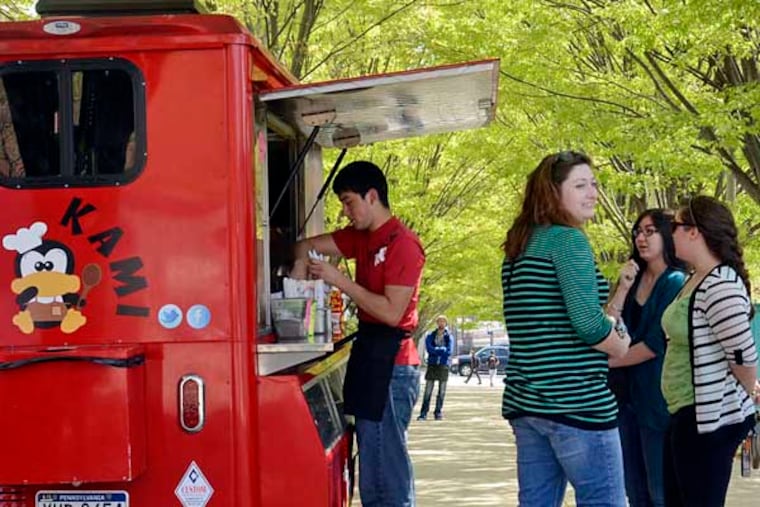Jewish foods, non-wheat noodles top 2014 trends
When Michael Solomonov was cooking at Striped Bass a decade ago, his pastrami-spiced gravlax was something of a novelty. Today, though, the smoky, briny, spicy preparation is being applied to just about everything, from the brisket with pastrami jus at Sbraga to pastrami-smoked chioggia beets at Vedge.

When Michael Solomonov was cooking at Striped Bass a decade ago, his pastrami-spiced gravlax was something of a novelty. Today, though, the smoky, briny, spicy preparation is being applied to just about everything, from the brisket with pastrami jus at Sbraga to pastrami-smoked chioggia beets at Vedge.
That's no coincidence. Flavors from the old-school Jewish deli - think rye bread, bagel toppings, and a schmear of schmaltz - are among the food trends expected to bubble to the top in 2014, according to forecasters.
Solomonov is betting on it. This spring, he'll be opening Abe Fisher, a restaurant devoted to "foods of the Jewish Diaspora."
"It's food that we ate growing up," Solomonov says. "It's great, because people are now interested in Jewish foods, and we can be a bit more proud and less secretive about what it is we're doing."
He expects that interest to reach beyond pastrami. Already, Marigold Kitchen is offering an "everything" carrot with pumpernickel "soil," and the guys at Cheu Noodle Bar have been channeling their inner bubbe (grandmother) with a matzo-ball-and-brisket soup. Restaurant consultant Michael Whiteman of New York's Baum & Whiteman predicts more Jewish fusion to come.
Vedge's Rich Landau says he doesn't focus on food fads, but when he does check in, "I try to read the blogs in L.A., because it seems like what happens in L.A. then is picked up in New York the next year, and then after that it gets to Philadelphia."
Here, then, are more trends that may be Philly-bound in 2014.
The post-wheat era. The National Restaurant Association, which surveyed 1,300 chefs, reports that non-wheat noodles - such as quinoa or rice pasta - will be big this year. Buckwheat pasta has already hit menus from Rittenhouse Square's Vernick to the quick-serve WokWorks a few blocks away. "That speaks to the gluten-free movement," says the association's director of nutrition, Joy DuBost. It's also about the hunt for the next best thing, says Landau, who's been making buckwheat crepes and experimenting with the latest trendy grain, freekeh. "Any restaurant that serves rice right now is kind of a step behind."
Pickling and fermenting. From kimchi to chow-chow, all things brined, fermented, and preserved are expected to keep through 2014, according to the consultancy Technomic. Old City restaurateur Ellen Yin - whose High Street on Market is topping roast pork with fermented broccoli rabe - says that reflects both the quest for new flavor profiles and a likewise-trending preference for local produce. "We started this fermentation program to try to extend the life of some of the stuff we're getting from our local farms," she says.
Food trucks. The Philly food-truck scene will continue to mature, predicts local restaurant consultant Harris Eckstut. A board member of the Philly Mobile Food Association, he expects more truck offshoots of brick-and-mortar eateries. "It's a great marketing tool," he says. He also thinks the city will finally pass long-awaited truck-friendly regulations this year.
Wine on tap. Thanks to new state legislation, wines began flowing through draft lines in 2013 at Marc Vetri's Alla Spina and Pizzeria Vetri and the Fishtown gastropub Johnny Brenda's. Technomic forecasts the arrival of even more taps, like the self-serve beer taps at Midtown Village's Brü Craft & Wurst, and more places like Tria Taproom, which sells beer, cider, wine, and soda exclusively on tap.
Hipster Asian. Local restaurant consultant Harris Eckstut expects growth in ethnic foods, driven by value-seeking customers. In particular, Whiteman expects more "hipster Asian" eateries, like Cheu Noodle, serving up cross-cultural menus in stripped-down spaces, inspired as much by the Brooklyn restaurant scene as any authentic Asian cuisine.
Oily fish. Whiteman predicts the mackerel will be running this year, along with sardines, anchovies, and other "fishy fish," as people who previously defaulted to salmon or snapper seek stronger flavors. "In an age of luxury," he adds, "there's a certain sense of slumming that becomes trendy. You find people eating food that their grandparents or great-grandparents ate . . . and our parents strove to get away from."
Kids' nutrition. The restaurant association survey found an emphasis on healthier options for kids, such as grilled chicken and steamed broccoli at chains including Chili's. But don't look for radical kids'-menu overhauls, DuBost says. "It is easier to introduce newer, healthier items than to modify or tweak items that consumers go there for. You tweak the traditional menu options, and you may get a backlash."
Shopping goes social. Phil Lempert, ConAgra's "Supermarket Guru," says 60 percent of consumers already shop smartphone in hand. But he expects that by the summer more shoppers will be aiming phone cameras at packages to get additional information. He also expects more supermarkets to add "culinary collaboration centers." He points to Jeff Brown's Philly-area ShopRites, which bring in chefs and nutritionists. "That's what they have to do to not just stop the money leaving their stores, but to bring it back. It's all about relationships."
More trends. When it comes to food fads, the list is nearly endless: The restaurant association identified 209 potential trends for 2014. But, ultimately, it's not that important whether kale will stay fresh for another season (it will, forecasters say), or whether sriracha will remain hot (it won't, says Whiteman, who expects cooks to start reaching for Korean gochujang instead).
More than anything, Landau says, "People want [food] to be exciting and interesting. If you hit that note with people, you become that micro-trend of your own."
215-854-5053
@samanthamelamed